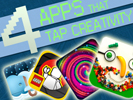Visual Schedule
source: Susan Stokes
Definition: A daily visual schedule is a critical component in a structured environment. A visual schedule will tell the student with autism what activities will occur and in what sequence.
"Visual Schedule"
 Example: Object schedule, 3 ring binder schedule, clipboard schedule, manila file folder schedules, dry erase board schedules, Velcro strip across the top of the desk, etc.
Example: Object schedule, 3 ring binder schedule, clipboard schedule, manila file folder schedules, dry erase board schedules, Velcro strip across the top of the desk, etc.
"Visual Schedule"
- Visual schedules are important for children with autism because they:
- Help address the child's difficulty with sequential memory and organization of time.
- Assist children with language comprehension problems to understand what is expected of them (5).
- Lessen the anxiety level of children with autism, and thus reduce the possible occurrence of challenging behaviors, by providing the structure for the student to organize and predict daily and weekly events. Schedules clarify that activities happen within a specific time period (e.g., understanding that "break time" is coming, but after "work time"), and also alert the student to any changes that might occur.
- Assist the student in transitioning independently between activities and environments by telling them where they are to go next (5). Visual schedules can be used in all environments (e.g., classroom, gym, Occupational Therapy, Speech/Language Therapy, home, Sunday School, etc.).
- Are based on a "first-then" strategy; that is, "first you do ___, then you do ___", rather than an "if-then" approach (i.e., "if you do ___, then you can do___"). This first-then strategy allows the "first" expectation (whether a task, activity or assignment) to be modified, as needed. The modification is in terms of task completion and amount of prompting, in order to accommodate the student's daily fluctuations in his ability to process in-coming information. Then he can move on to his next visually scheduled task/activity.
Example: A student is having particular difficulty completing a math worksheet, due to anxiety, sensory processing difficulties, communication, difficulty generalizing, internal/external distracters, change, etc. The assignment can be modified so that the child only has to complete three math problems first, and then he has a sensory break, as indicated on his visual schedule.
- Can incorporate various social interactions into the student's daily schedule (e.g. showing completed work to a teacher/parent for social reinforcement, requiring appropriate social greetings).
- Can increase a student's motivation to complete less desired activities by strategically alternating more preferred with less-preferred activities on the student's individual visual schedule.
Example: By placing a "computer" time after "math", the student may be more motivated to complete math knowing that "computer" time will be next.
A visual schedule for a student with autism must be directly taught and consistently used. Visual schedules should not be considered as "crutches" for students with autism, from which they should gradually be "weaned". Instead, these individual visual schedules should be considered as "prosthetic" or "assistive tech" devices. For the student with autism, the consistent use of a visual schedule is an extremely important skill. It has the potential to increase independent functioning throughout his life - at school, home and community.
- Developing Visual Schedules: In general, schedules should be arranged from a "top-to-bottom" or "left-to-right" format, including a method for the student to manipulate the schedule to indicate that an activity is finished or "all done" .
Example: Cross/mark off with a dry erase marker, place the item in an "all done" envelope/box, check off the item, draw a line through the scheduled activity, etc.
- A minimum of two scheduled items should be presented at a time so that the student begins to understand that events and activities happen in a sequential manner, not in isolation.
- Schedules can be designed using a variety of formats, depending upon the needs of the individual student.
"Visual Schedule"
 Example: Object schedule, 3 ring binder schedule, clipboard schedule, manila file folder schedules, dry erase board schedules, Velcro strip across the top of the desk, etc.
Example: Object schedule, 3 ring binder schedule, clipboard schedule, manila file folder schedules, dry erase board schedules, Velcro strip across the top of the desk, etc. - Various visual representation systems can be used for an individual visual schedule including:
Real objects;
Photographs (e.g., "Picture This" software program or own photos);
Realistic drawings;
Commercial picture system (e.g., "Boardmaker" software program);
Written words/lists.
"Visual Schedule"
- Individual Schedule: It is necessary to develop an individual schedule for the child with autism in addition to the general classroom schedule.
- An individual schedule will give the child with autism important information in a visual form that he can readily understand.
- Another consideration when individualizing a schedule for a student with autism is the length of the schedule (number of activities). The length of the schedule may need to be modified due to the student becoming increasingly obsessed and/or anxious regarding an up-coming scheduled activity, or due to difficulty in processing "too much" information presented at once.
- Check Schedule. Some students may need a "check schedule" visual physical prompt to teach them to independently check their schedule, as well as learn the importance of their schedule.
- Transitions. Some students may need to transition to the next scheduled activity by taking their scheduled item (card or object) off their individual schedule and carrying this with them to the next activity/location. This may be due to the child's increased distractibility in maneuvering through the environment. The distractibility, or inability to sustain attention throughout the transition, is independent of the child's cognitive functioning level or verbal skills.
Example: A particular student "obsesses" over recess. If at the beginning of his day he sees "recess" scheduled later in the morning, he will continue to be obsessed with "going out for recess", resulting in increased anxiety and distractibility for the rest of the morning activities until recess. The student's schedule could be created with a few activity items at a time, up until recess. Again, individualization is the key to success.
Example: "Check schedule" visual prompts can be made by writing the student's name on laminated colored paper strips or using popsicle sticks or poker chips with a large check printed on the chip, etc.
The "check schedule" prompts are visual and physical cues (as opposed to adult prompts) given to the student for any transition in his daily activities, to cue him to check his schedules.
A child who relies too heavily on adult prompts rather than using "check schedule" prompts in with his schedule, may have more difficulty understanding the importance of his schedule and have limited success in using it.Example: Some non-verbal students with autism, who function at a younger cognitive level, do not require transition schedule cards to get to the next scheduled activity. On the other hand certain higher functioning students with autism require a transition card to get to the next scheduled activity, due to their increased distractability.










